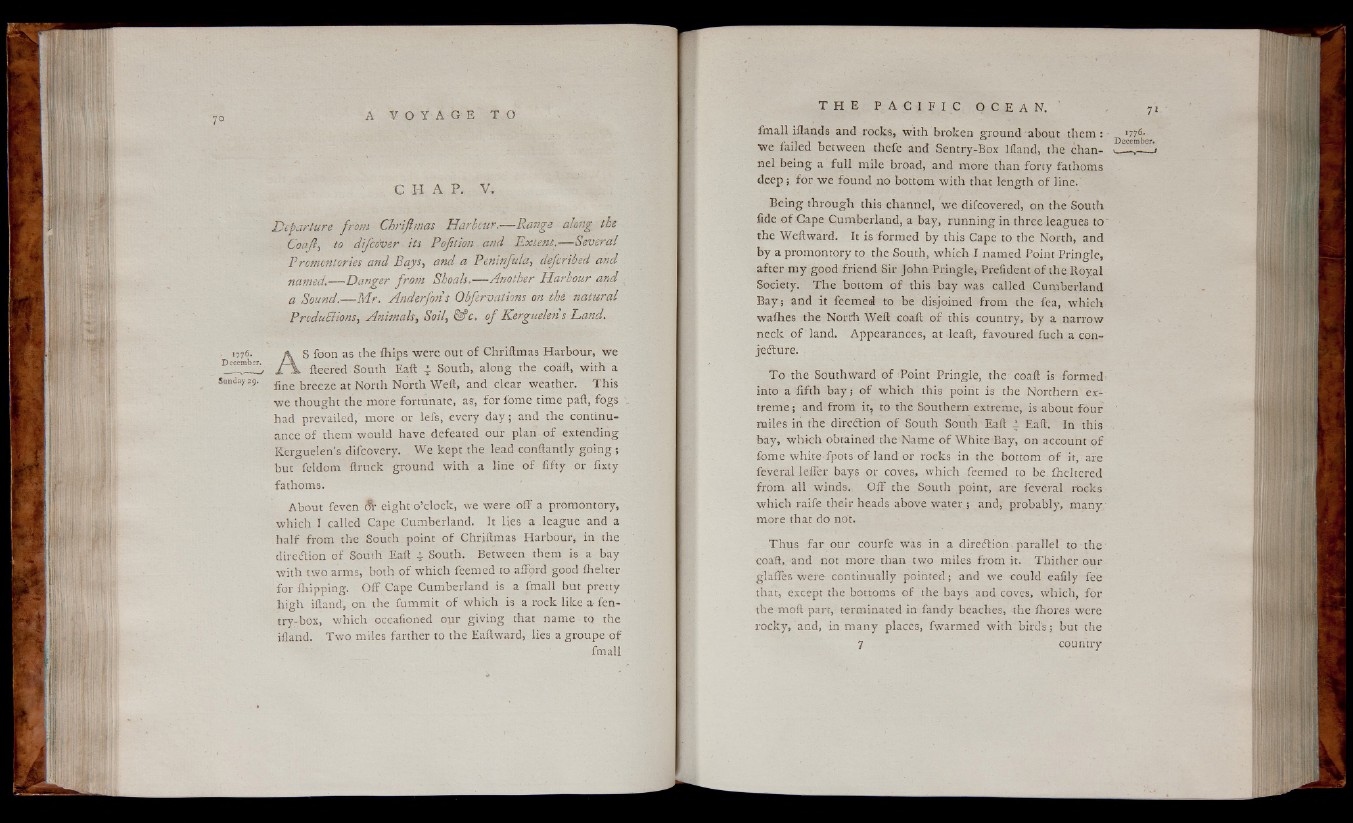
C H A P. V.
Departure from Chrijìmas Harbcur.— Range along the
Coajì, to difcdver its Pojition and E x ten t.— Several
Promontories and Bays, and a Peninfula, defcribed and
named.— Danger from Shoals.— Another Harbour and
a Sound.— M r. Anderfotis Obfervations on thè natural
Productions, Anim als, Soil, & c . o f Kerguelen s Land.
■ >776. A S foon as the fhips were out of Chriftmas Harbour, we
l \ fleered South Eaft Ì South, along the coàft, with a
Sunday 29. flne breeze at North North Weft, and clear weather. This
we thought the more fortunate, as, for fome time paft, fogs
had prevailed, more or lefs, every day; and the continuance
of them would have defeated our plan of extending
Kerguelen’s difcovery. We kept the lead conftantly going ;
but feldom flruck ground with a line of fifty or fixty
fathoms.
About feven or eight o’clock, we were off a promontory,
which I called Cape Cumberland. It lies a league and a
half from the South point of Chriftmas Harbour, in the
direction of South Eaft 4. South. Between them is a bay
with two arms, both of which feemed to afford good ihelter
for fhipping. Off Cape Cumberland is a fienali but pretty
high ifland, on the fummit of which is a rock like a- fen-
try-bOx, which occafioned our giving that name to the
ifland. Two miles farther to the Eaftward, lies a groupe of
fmall
fmall iflands and rocks, with broken ground about them : • '776-
we failed between thefe and Sentry-Box Ifland, the chan- ■ — *
nel being a full mile broad, and more than forty fathoms
deep; for we found no bottom with that length of line.'
Being through this channel, we difcovered, on the South
fide o f Cape Cumberland, a bay, running in three leagues to-
the Weftward. It is formed by this Cape to the North, and
by a promontory to the South, which I named Point Pringle,
after my good friend Sir John Pringle, Prefident of the Royal
Society. The bottom of this bay was called Cumberland
Bay; and it feemed to be disjoined from the fea, which
walhes the North Weft coaft of this country, by a narrow
neck o f land. Appearances, at-leaft, favoured fuch a conjecture.
To the Southward of Point Pringle, the coaft is formed
into a fifth bay; of which this point is the Northern extreme;
and from it, to the Southern extreme, is about four
miles in the direction of South South Eaft Eaft. In this .
bay, which obtained the Name of White Bay, on account of
fome whiteffpots of land or rocks in the bottom of it, are
feveral leffer bays 01- coves, which feemed to be fheltered
from all winds. OIF the South point, are feveral rocks
which raife their heads above water ; and, probably, many
more that do not.
Thus far our courfe was in a direction parallel to the
coaft,, and not more than two miles from it. Thither our
glaffes were continually pointed; and we could eafily fee
that, except the bottoms of the bays and coves, which, for
the moil part, terminated in fandy beaches, the fhores were
rocky, and, in many places, fwarmed with birds; but the
7 country